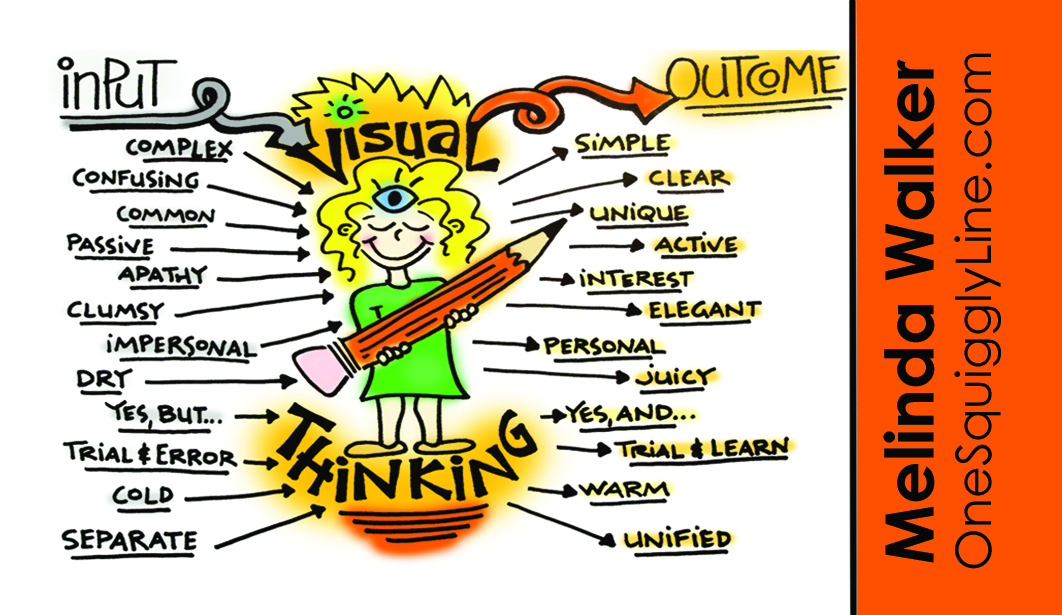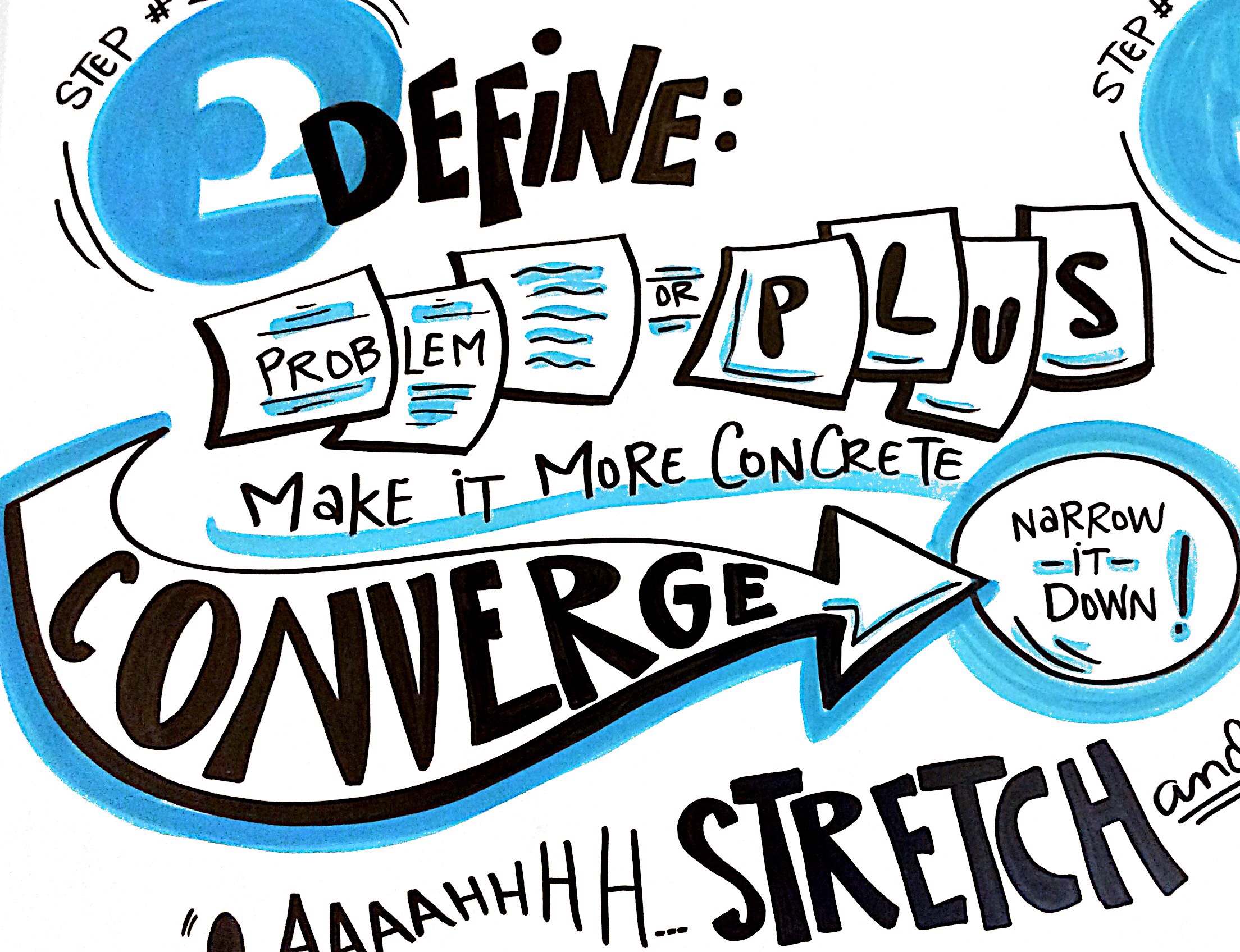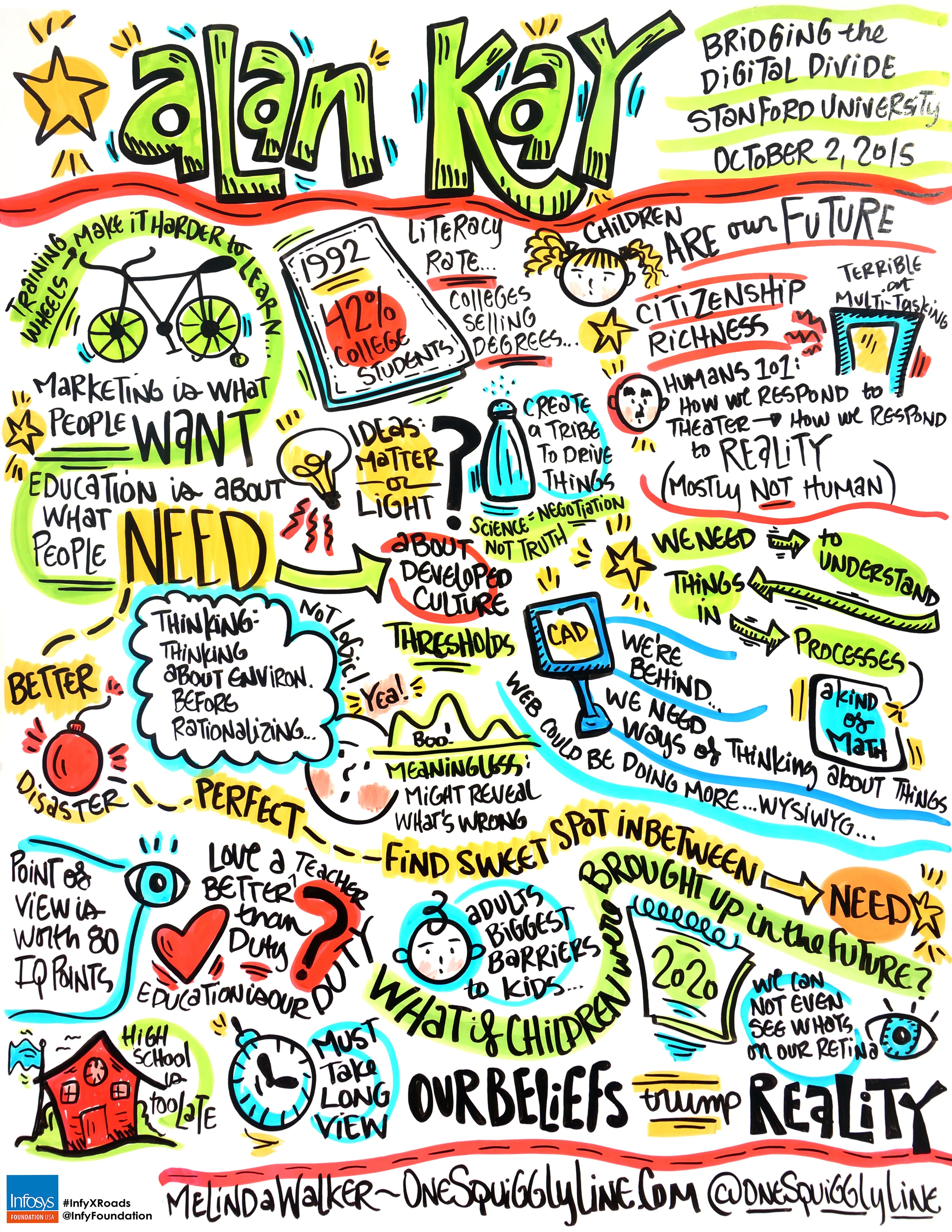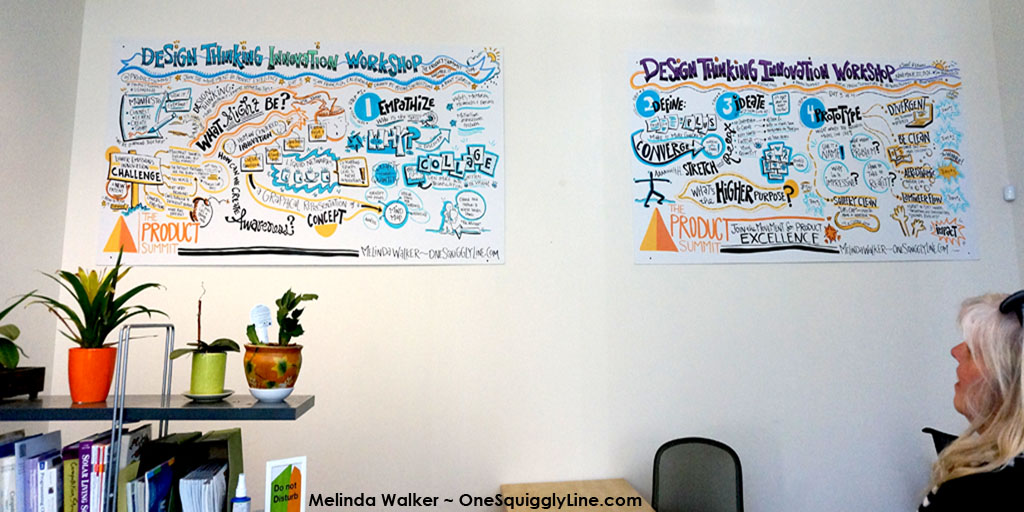When working live, you never know what's going to happen. I usually only have the same information the people in the audience have, which is a basic agenda. So I know the speaker's name, title of their talk, and how long they are scheduled to speak. That's it!
It's not uncommon for talks to go longer as planned, like the one above. That's usually a good sign, as it means the audience is really engaged. But it can be a challenge to capture all that extra content on the same page.
Color is a great way to keep things organized when there's not much space available. Grouping concepts and thoughts according to color allows you to have completely different ideas right next to each other without things getting confusing.
See more visual notes created live at One Squiggly Line's graphic recording page.
Visual Thinking: Words & Pictures Together
What grabbed your attention first — the image above or the big chunk of text below?
Odds are, the image grabbed your eye first. It's probably the main reason you're reading the text in the first place!So go back to the image for a minute.Really look at it. READ it.
Now, read the paragraph below:
Visual thinking makes complex information simple, brings clarity to confusing communication, makes the common unique, turns the passive into the active and apathy into interest. With visual thinking, the clumsy becomes elegant, the impersonal becomes personal, the dry becomes juicy, "Yes, but..." is replaced with "Yes, and...", trial and error turns to trial and learn, the cold becomes warm, and the separate become unified.
That paragraph and the accompanying image say the same thing!Most people find the information easier to absorb through the image than the paragraph.They're able to absorb that information faster and remember it longer. And, it's a lot more fun!
Check out One Squiggly Line'sAbout Visual Thinking page to learn more.
Creativity: Creative Combinations
Creativity
There's a myth out there that highly creative people just sit around and wait for inspiration to strike. Like a great big lightening bolt from the sky. Or a soft whisper from a mystical muse.
Truth is, creativity is not quite so passive. It is an active process. And there's a science to it, not just an art. There are even formulas, methods, and procedures for generating ideas and, equally importantly, evaluating them.
One classic way to create something new is to combine two things. Take the markers above, for example. Nothing new about a round tip marker. Or a brush tip marker. But when you put them both in one pen, you end up with a whole new product!
Learn More About Visual Thinking
Creativity: Failure & the Creative Life
Why are we afraid of failure?
It’s embarrassing. It’s humiliating. And perhaps it makes us feel weak and small inside.
When’s the last time you failed? How did it make you feel? Do you remember your reaction?
Perhaps it was a test. Poor performance at work. An interview. Suggesting a new idea.
Were you nervous? Did you cry? Get angry? Did you shy away and never try again?
Oftentimes these emotions are uncomfortable. Although difficult to experience, they lead to some of the most important lessons, opening up many doors for us later on in life.
We live in a culture where everything appears to be perfect and “normal” on the outside. Our social media accounts portray this.
The reality is that life is messy. We’re not always perfect people. And if we try to always stay within the lines, we’ll never know what lies beyond.
It’s important to allow ourselves to be open to failure and rejection, because on the other side is a reward - either a lesson to be learned, or you achieve what you intended.
This doesn't mean to be stupid with our failures, but rather, to be smart with our intentions and our reactions.
It’s not the failure itself that’s important. What’s important is that we learn from our failures and implement these lessons into our lives.
Ask yourself: If I fail at this, what’s the worst that can happen?
Failure is one of the most important tools for a creative life.
When we’re comfortable encountering failure and rejection, only then will we be able to experience results that we’ve never seen before.
A creative life is one that has experienced failure multiple times - not recoiling from it, but embracing, learning and implementing its lessons.
Failure is a steppingstone to personal success and creativity.
Learn more about Visual Thinking
Creativity: 10 Ways to Shake Things Up!
Take a cold shower
This will likely be an unfamiliar experience, allowing you to create new neural connections.
Make a new meal without a recipe
This will force you to be comfortable without all of the answers in front of you
Try a new hairstyle
A new change could inspire you!
Create a new outfit that you’ve never worn before
Mixing and matching will help you form new styles. A new outfit can give you a new vibe, which can inspire confidence.
Journal about your day
This reflection time will allow you to absorb what you’ve learned throughout the day. Journaling will also allow you to look back on old memories and see patterns in your life.
Take a new route that you haven’t taken before
This will give you a new perspective. This will take you out of auto-pilot mode, and force you to think in different ways.
Rearrange your room or living space
This can create a fresh environment and get you out of a routine feeling
Ask more questions
The more curious you are, the more you will learn.
Limit or eliminate social media for a day
You can use the extra time gained from eliminating social media to be more productive. You can spend this time in silence. It will likely be an unfamiliar experience.
Exercise your body and mind
Whether working out, doing yoga or meditating, this will allow your body and mind to relax and take a break from life.
Giving your mind a break allows creative ideas to flow naturally.
Hire me to shake things up for you!
Visual Thinking & Visual Notes: Live Graphic Recording
People often think I do a lot of drawing while taking live visual notes. If you really look at the image above, you'll see there's really not much drawing there at all. Just some squares, a couple of circles, and an arrow. That's it!
When you write words inside simple shapes, those simple shapes start making your own notes a bit more visual. They become more dynamic. More interesting. The image and the message become more unified. And far more powerful.
A great way to make your own notes more visual is to write some of your words inside simple shapes — circles, squares, triangles, arrows, etc. Give it a try!
The image above is a close-up of a 4'x8' drawing, created live, in real-time during a Design Thinking workshop. Be sure to check out the entire image!
Visual Thinking & Live Visual Notes: Graphic Recording
When working live, you never know what's going to happen. I usually only have the same information the people in the audience have, which is a basic agenda. So I know the speaker's name, title of their talk, and how long they are scheduled to speak. That's it!
It's not uncommon for talks to go longer as planned, like the one above. That's usually a good sign, as it means the audience is really engaged. But it can be a challenge to capture all that extra content on the same page.
Color is a great way to keep things organized when there's not much space available. Grouping concepts and thoughts according to color allows you to have completely different ideas right next to each other without things getting confusing.
See more visual notes created live at One Squiggly Line's graphic recording page.
Graphic Recording: What to Do With Your Boards After Your Event
One of the great things about graphic recording is that it's big. Really big. Often 8 feet long by 4 feet high. To put that in perspective, a Smart Car is almost 9 feet long and about 5 feet wide. That's just about a foot bigger than a lot of graphic recording work!
Graphic recording literally gives you the big picture. So why not make the most of it! Like the creative folks at Tech Liminal in downtown Oakland, CA. As you can see in the photo above, they hung their boards right on the wall. That way, every one who comes in can seen what they've been up to. And for those working there, creative inspiration is just a glance away.
The two graphic recording boards above were created live at The Product Summit a few months ago. Each board is 8 feet long by 4 feet high.
Live Graphic Recording: Design Thinking Innovation Workshop at The Product Summit
Workshops are generally made of PowerPoint presentations, hands-on work, and lively discussions. Graphic recording is a great way to capture both the facts and the flavor of the group, giving everyone (present or not) a clear picture of the key points and the experience as a whole. It's also a great way to show the whole group how much of an impact each person's participation has on everyone's experience there.
The two images above were created during the full day Design Thinking Innovation Workshop last Saturday, as part of The Product Summit in San Francisco.










